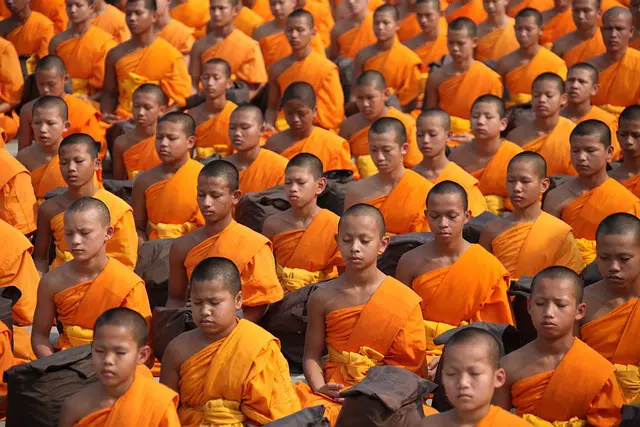Buddhism is a major world religion and also a philosophy that originated around the 6th century BCE. Founded by Siddhartha Gautama commonly known as Buddha which refers to “The awakened one”.
We have 4 truths related to Buddhism which provide us with an understanding of the suffering, and the path to peace.
These truths somewhere state that suffering is an important part of human existence.
Suffering arises from attachment, craving. Buddhism also states that there is also an end to suffering. It will take time but suffering will surely end.
Teachings of Buddhism
Central to Buddhist teachings is the concept of impermanence (anicca), which asserts that all phenomena, including the self, are in a state of constant change. The belief in rebirth (samsara) is also central, positing that individuals go through a cycle of birth, death, and rebirth, determined by their actions (karma) in previous lives.
Meditation and Buddhism
Buddhism focuses on the practice of meditation and mindfulness as means to gain insight into the true nature of reality, awakening inner peace, and attain enlightenment or liberation (nirvana). The ultimate goal of Buddhism is to break free from the cycle of rebirth and achieve liberation from suffering.
Traditions and Buddhism
Buddhism has always taught us different traditions such as Theravada, Mahayana, and Vajrayana, and each of these has its own practices, scriptures, and explanations While Buddhist practices and beliefs may vary across different cultures, the core teachings of the Buddha remain central to all Buddhist traditions.
Till now we understood that Buddhism as a religion as a teaching has always taught us something.
And Gautama Buddha will always remain our teacher who thought about people’s miseries and had always something nice to offer.
But what about now? When we need someone to teach where is Buddhism.
Why it doesn’t exist now?
Yes, Buddhism had started declining in India due to various reasons.
One factor can’t be pinpointed but it is assumed to have some reasons. Let’s see some of them below.
Why Buddhism Declining in India?
1 ) Hindu Revival: During the Gupta Empire (4th to 6th centuries CE), there was rebirth of Hinduism, which became the dominant religious and cultural force in India.
Hindu rulers reconstructed Hindu temples, rituals, and Brahmin priests were threatened leading to a decline in support for Buddhism.
2) Brahminical Opposition: Brahminical orthodoxy, represented by the influential Brahmin caste, considered Buddhism a threat to their religious authority. Brahminical scholars engaged in theological debates and philosophical discussions, seeking to undermine Buddhist teachings.
This opposition likely played a role in the decline of Buddhism.
3) Decline of Royal Patronage:
During the royal period during the Maurya and Gupta rule Buddhism flourished as a religion as a teaching. However, as political dynasties changed, some rulers shifted their support away from Buddhism.
With declining royal rule, Buddhist monastic institutions suffered from a lack of financial and institutional support which led to decline of Buddhism.
4). Economic and Social Changes: Economic and social changes, including the breakdown of the urban trade network, the rise of feudalism, and changes in agrarian structures, impacted Buddhist monastic communities.
These changes affected the availability of resources, leading to the decline of monastic institutions and the migration of monks to other regions which again resulted in the closing of monk institutes.
5.) Islamic Invasions: From the 8th century onwards, various Islamic invasions and the establishment of Muslim rule in North India led to the destruction of Buddhist monasteries and the destruction of Buddhist communities leading to decline of buddhism all over india.
The arrival of Islam as a dominant religion significantly impacted the religious landscape of India, with Buddhism being one of the religions affected.
6) Foreign Invasions: In addition to Islamic invasions, the later periods of Indian history saw invasions and rule by various foreign powers such as the Kushans and the Huns.
These invasions disrupted the social fabric of the region and led to the decline of Buddhist institutions and the end of their influence in the country.
7) Lack of Effective Leadership: The Buddhist monastic community (Sangha) played a crucial role in the dissemination and preservation of Buddhist teachings. However, over time, there were challenges in maintaining effective leadership within the Sangha.
Issues such as corruption, lax discipline, and internal power struggles undermined the authority and credibility of Buddhist monastic institutions.
Obviously if there will be no one to take forward the teachings of the peaceful religion it will end and that happened.
8) Internal Divisions and Sectarianism: Over time, Buddhism in India separated into various sects and schools, each with its own interpretations and practices. Internal divisions and sectarian conflicts weakened the unity and strength of the Buddhist community making it more susceptible to decline.
Once a peaceful religion was just a long lost history.
9) Loss of Support from Local Communities:
As it spread to various regions in India, it encountered different local cultures and traditions.
In some cases, the local communities did not fully embrace Buddhism or integrate it into their existing practices.
The lack of strong support from local communities may have hindered the growth and sustainability of Buddhism in those areas.
It was always said that Buddhism was a peaceful religion but it never got that much support because of different practices, traditions.
Today’s growing world needs Buddhism back. They teach peacefulness. The message to hug every obstacle and turn it into a lesson is the need of the hour and this lesson needs to be learned by us and the whole world. And somewhere it is only possible if Buddhism will be back.
I don’t know if it’s possible or not. But I know for a fact teachings in Buddhism can never be made again. Buddhism only declined in India but in other countries it only continued to grow.
Also Read: Top 50 Richest Persons in Japan [2024]

1 Comment